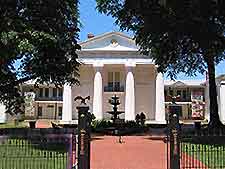Little Rock History Facts and Timeline
(Little Rock, Arkansas - AR, USA)

Spread out along the Arkansas River and overlooked by the Quachita Mountains, the city of Little Rock lies on land settled for thousands of years by Native Americans, including the Cherokee, the Choctaw and the Quapaw.
In 1722, history records that a French explorer arrived by boat, landing close to a rocky outcrop, establishing a trading post on a river crossing outside an Indian village and naming the area 'La Petite Roche', or Little Rock as it is better known today.

Troubled Times
Almost 100 years later, in 1812, fur trapper William Lewis arrived and built a cabin close to the rocky outcrop. By 1820, the area had been surveyed as a developing town and, a year later, history was made when Little Rock was established as the capital of the newly-formed Arkansas Territory, later being incorporated as the 25th state of the USA in 1836. By 1861, the city was allied to the Confederates and embroiled in the American Civil War, with Union troops in occupation by 1863.
Reconstruction of the city after the Union victory was violently interrupted by political infighting between Democrats and Republican candidates, who were vying for control of Little Rock and were nicknamed 'scalawags' and 'carpet-baggers'. Known locally as the Brooks-Baxter War, the conflict involved intimidation, electoral fraud and street fighting by the opposing militia gangs. In desperation, US President Ulysses S. Grant intervened, supporting the then Republican governor, Elisha Baxter, and bringing an end to the conflict.
Reconstruction, Growth and Civil Rights
The late 19th and early 20th century saw the construction of most of the city's heritage buildings and the birth, in 1880, of the great military strategist General Douglas MacArthur, who is most famous for his leading part in the occupation of
Japan post-WWII. However, the city's pivotal claim to fame came in 1957, during the heat of the African-American Civil Rights Movement, when, after months of public protest, the 'Little Rock Nine' were enrolled in the city's racially-segregated Central High School.

The move, supported by US Army troops and instigated after a 1954 Supreme Court ruling, began the Little Rock Crisis. During this time the students were prevented (by the State Governor, troops of the Arkansas National Guard and mobs of segregationalist townspeople) from attending classes until the intervention of President Eisenhower, whose action polarized the nation.
Even after their admission, the nine students were subjected to physical and verbal abuse by their classmates for almost a year until all local high schools were closed for one year, as the city fathers continued to fight for segregation. The 'Lost Year' was crucial to the fight for full African-American integration in the South, which climaxed with the assassination of Dr. Martin Luther King.
The Late 20th Century History
The Little Rock Central High School is still in operation and today holds a Civil Rights Museum, with this attractive Art Deco building now a National Historic Site that is popular with visitors. By the 1970s, construction and cultural events were booming in the city and its historic areas began undergoing restoration. In 1992, Arkansas presidential candidate Bill Clinton gave his election acceptance speech from the steps of the Old State House in downtown Little Rock, putting the city on the political map yet again.
 Spread out along the Arkansas River and overlooked by the Quachita Mountains, the city of Little Rock lies on land settled for thousands of years by Native Americans, including the Cherokee, the Choctaw and the Quapaw.
Spread out along the Arkansas River and overlooked by the Quachita Mountains, the city of Little Rock lies on land settled for thousands of years by Native Americans, including the Cherokee, the Choctaw and the Quapaw.
 The move, supported by US Army troops and instigated after a 1954 Supreme Court ruling, began the Little Rock Crisis. During this time the students were prevented (by the State Governor, troops of the Arkansas National Guard and mobs of segregationalist townspeople) from attending classes until the intervention of President Eisenhower, whose action polarized the nation.
The move, supported by US Army troops and instigated after a 1954 Supreme Court ruling, began the Little Rock Crisis. During this time the students were prevented (by the State Governor, troops of the Arkansas National Guard and mobs of segregationalist townspeople) from attending classes until the intervention of President Eisenhower, whose action polarized the nation.